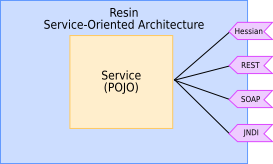
Resin Documentationhome company docs
app server 
app server

a simple service for resin remoting
Writing a service for the Resin remoting as a plain-old Java object (POJO) eliminates protocol dependencies and simplifies service testing. With the Resin remoting, services can be written as plain-old Java objects (POJOs) and made available to many different protocols using simple configuration changes.
 The Resin remoting is an infrastructure that allows a service to be exposed via many different service protocols. For example in this tutorial, there is a plain-old Java object (POJO) that implements a service and this service is made available using REST, SOAP, Hessian, and WebBeans. The service is implemented once and these protocols are activated with a few simple changes to the configuration file. In this example, the service interface is for a simple Hello, World service.
There is a single method, HelloService.java
package example;
public interface HelloService {
/**
* Returns "hello, world".
*/
public String hello();
}
The HelloService implementation is just a Java class that implements the HelloService API. It can optionally use EJB annotations like @Remote, @Stateless or @TransactionAttribute. HelloServiceImpl.java
package example;
public class HelloServiceImpl implements HelloService {
/**
* Returns "hello, world".
*/
public String hello()
{
return "hello, world";
}
}
Services for Resin remoting are configured with the <servlet>
tag. The implementation class is given as
the To expose the service as a Hessian service, use the <hessian> tag. Hessian is one of the protocols available for web services. Finally, a SOAP interface is available, using CXF or XFire. remoting service for hessian
<web-app xmlns="http://caucho.com/ns/resin">
<servlet-mapping url-pattern="/hello/hessian/*"
servlet-class="example.HelloServiceImpl">
<protocol uri="hessian:"/>
</servlet-mapping>
</web-app>
remote service for CXF
<web-app xmlns="http://caucho.com/ns/resin">
<servlet-mapping url-pattern="/hello/hessian/*"
servlet-class="example.HelloServiceImpl">
<protocol uri="cxf:"/>
</servlet-mapping>
</web-app>
service as WebBeans singleton <web-app xmlns="http://caucho.com/ns/resin"> <bean class="example.HelloServiceImpl" name="vm"/> </web-app> Resin also makes it easy to access services using the <remote-client> tag. This tag connects to a service using a URI of the form <protocol>:url=<location>. The example below shows just such a URL. The interface of the service is required. The <remote-client> tag creates a proxy client instance for the service and registers the proxy with WebBeans. <remote-client>
<web-app xmlns="http://caucho.com/ns/resin">
<remote-client interface="example.HelloService" name="hessian">
<uri>hessian:url=${webApp.url}/hello/hessian/</uri>
</remote-client>
<remote-client interface="example.HelloService" name="rest">
<uri>rest:url=${webApp.url}/hello/rest/</uri>
</web-service-client>
<remote-client interface="example.HelloService" name="soap">
<uri>xfire:url=${webApp.url}/hello/soap/</url>
</remote-client>
</web-app>
The client can now connect to the HelloService using any supported encoding simply by doing a WebBeans injection. demo.jsp
<%@ page import="javax.webbeans.Named" %>
<%@ page import="example.HelloService" %>
<%!
@Named("hessian") HelloService _hessianHello;
@Named("rest") HelloService _restHello;
@Named("soap") HelloService _soapHello;
@Named("vm") HelloService _vmHello;
%>
<pre>
From Hessian: <%= _hessianHello.hello() %>
From REST: <%= _restHello.hello() %>
From SOAP: <%= _soapHello.hello() %>
From VM: <%= _vmHello.hello() %>
</pre>
From Hessian: hello, world From REST: hello, world From SOAP: hello, world From VM: hello, world The client can now connect to the HelloService
using PHP with the demo.php
<?php
$hessian = java_bean("hessian");
$rest = java_bean("rest");
$soap = java_bean("soap");
$vm = java_bean("vm");
?>
<pre>
From Hessian: <?= $hessian->hello() ?>
From REST: <?= $rest->hello() ?>
From SOAP: <?= $soap->hello() ?>
From VM: <?= $vm->hello() ?>
</pre>
From Hessian: hello, world From REST: hello, world From SOAP: hello, world From VM: hello, world
|